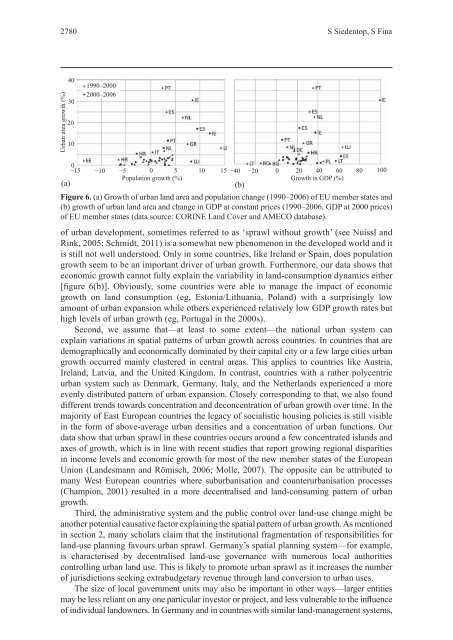PDF 20.134kB - TOBIAS-lib - Universität Tübingen
PDF 20.134kB - TOBIAS-lib - Universität Tübingen
PDF 20.134kB - TOBIAS-lib - Universität Tübingen
Sie wollen auch ein ePaper? Erhöhen Sie die Reichweite Ihrer Titel.
YUMPU macht aus Druck-PDFs automatisch weboptimierte ePaper, die Google liebt.
2780 S Siedentop, S Fina<br />
Urban area growth (%)<br />
40<br />
30<br />
20<br />
10<br />
0<br />
15<br />
1990–2000<br />
2000–2006<br />
10 5 0 5 10 15 40 20 0 20 40 60 80 100<br />
Population growth (%) Growth in GDP (%)<br />
(a) (b)<br />
Figure 6. (a) Growth of urban land area and population change (1990–2006) of EU member states and<br />
(b) growth of urban land area and change in GDP at constant prices (1990–2006, GDP at 2000 prices)<br />
of EU member states (data source: CORINE Land Cover and AMECO database).<br />
of urban development, sometimes referred to as ‘sprawl without growth’ (see Nuissl and<br />
Rink, 2005; Schmidt, 2011) is a somewhat new phenomenon in the developed world and it<br />
is still not well understood. Only in some countries, like Ireland or Spain, does population<br />
growth seem to be an important driver of urban growth. Furthermore, our data shows that<br />
economic growth cannot fully explain the variability in land-consumption dynamics either<br />
[ gure 6(b)]. Obviously, some countries were able to manage the impact of economic<br />
growth on land consumption (eg, Estonia/Lithuania, Poland) with a surprisingly low<br />
amount of urban expansion while others experienced relatively low GDP growth rates but<br />
high levels of urban growth (eg, Portugal in the 2000s).<br />
Second, we assume that—at least to some extent—the national urban system can<br />
explain variations in spatial patterns of urban growth across countries. In countries that are<br />
demographically and economically dominated by their capital city or a few large cities urban<br />
growth occurred mainly clustered in central areas. This applies to countries like Austria,<br />
Ireland, Latvia, and the United Kingdom. In contrast, countries with a rather polycentric<br />
urban system such as Denmark, Germany, Italy, and the Netherlands experienced a more<br />
evenly distributed pattern of urban expansion. Closely corresponding to that, we also found<br />
different trends towards concentration and deconcentration of urban growth over time. In the<br />
majority of East European countries the legacy of socialistic housing policies is still visible<br />
in the form of above-average urban densities and a concentration of urban functions. Our<br />
data show that urban sprawl in these countries occurs around a few concentrated islands and<br />
axes of growth, which is in line with recent studies that report growing regional disparities<br />
in income levels and economic growth for most of the new member states of the European<br />
Union (Landesmann and Römisch, 2006; Molle, 2007). The opposite can be attributed to<br />
many West European countries where suburbanisation and counterurbanisation processes<br />
(Champion, 2001) resulted in a more decentralised and land-consuming pattern of urban<br />
growth.<br />
Third, the administrative system and the public control over land-use change might be<br />
another potential causative factor explaining the spatial pattern of urban growth. As mentioned<br />
in section 2, many scholars claim that the institutional fragmentation of responsibilities for<br />
land-use planning favours urban sprawl. Germany’s spatial planning system—for example,<br />
is characterised by decentralised land-use governance with numerous local authorities<br />
controlling urban land use. This is likely to promote urban sprawl as it increases the number<br />
of jurisdictions seeking extrabudgetary revenue through land conversion to urban uses.<br />
The size of local government units may also be important in other ways—larger entities<br />
may be less reliant on any one particular investor or project, and less vulnerable to the in uence<br />
of individual landowners. In Germany and in countries with similar land-management systems,

















